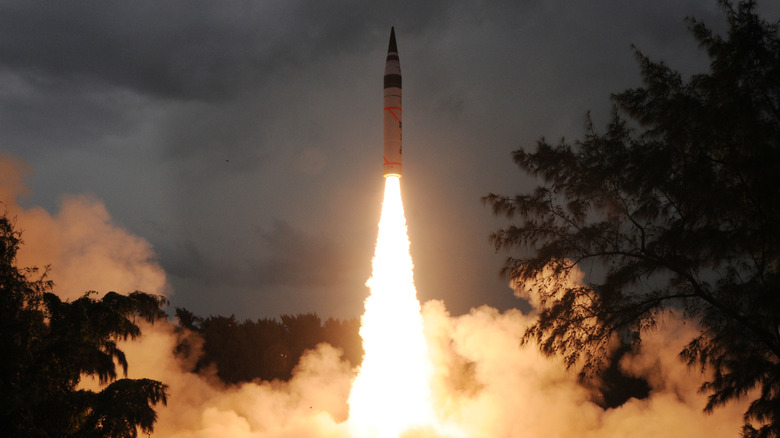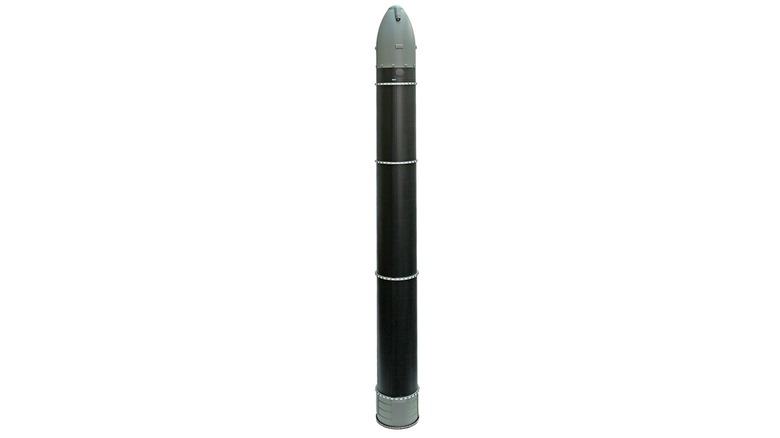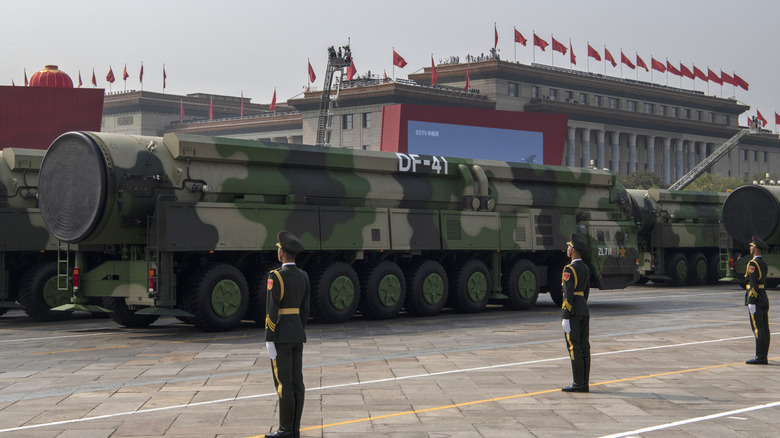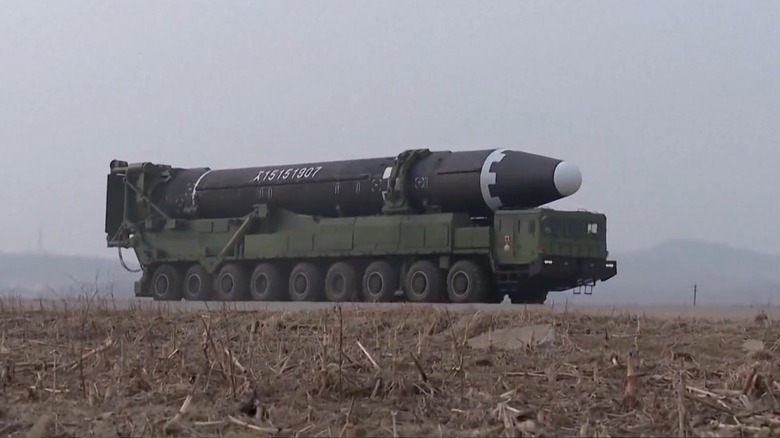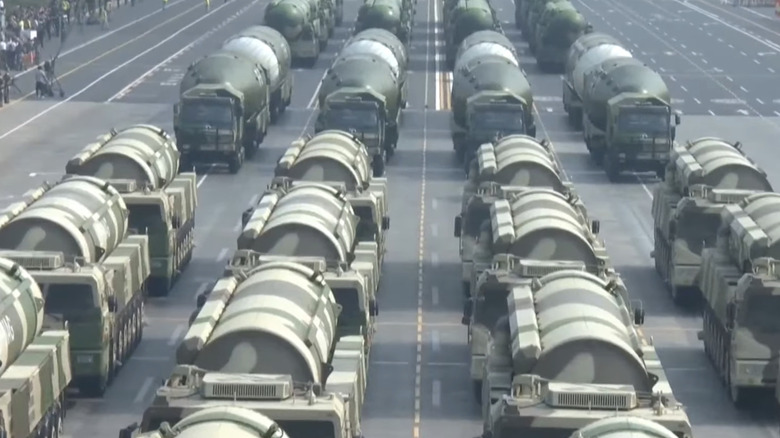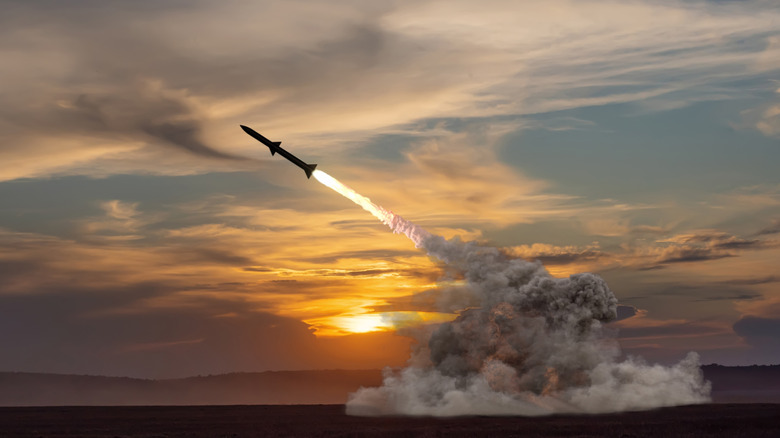5 Of The Longest-Range Missiles In The World (And The Countries That Own Them)
"Basically any object thrown at a target with the aim of hitting it is a missile. Thus, a stone thrown at a bird is a missile." That's how scientists at the Defence Research & Development Organisation (DRD), India's apex military research wing, defined a missile in a 1990 issue of Popular Science & Technology. In the modern age, missiles can do more than just kill a bird within a man's throwing range. Some can strike a target sitting continents or oceans apart.
The Mod 6 variant of Russia's R-36 (SS-18 "Satan") can theoretically take off from New York and destroy a target in Perth. Moreover, this intercontinental ballistic missile (ICBM) is capable of carrying a nuclear warhead, so there's that risk, too. The sheer destructive potential of today's missiles is unfathomable, especially considering their origins.
The first documented use of missiles is traced to the Battle of Kai-fung-fu in 1232, when the Chinese used what were essentially rocket-propelled arrows to thwart the Mongolian attacks. Within three centuries, rockets made their way into the European arsenal. The biggest shift arrived in the early 20th century, when minds like Robert H. Goddard and Wernher von Braun introduced the concept of liquid-propelled rockets.
The most notable of these early entrants was the A4 (later named V2), which was dropped on London in an effort to alter the course of World War II. Yet, it's also said to have heralded the modern space age. Development continued, and we're now at a point where missiles can fly thousands of miles and strike with deadly precision.
RS-28 Sarmat Satan II (Russia)
According to the Missile Defense Project database maintained by the Center for Strategic & International Studies, Russia has the most diverse inventory of ballistic and cruise missiles in the world. There are at least six missiles in the country's arsenal with a range exceeding six thousand miles. At the top of the chain is the RS-28 Sarmat, also known as SS-X-30 Satan II. With a claimed range of 6,213 to 11,184 miles, the Sarmat missile was first tested in 2015 and is now in military service.
Following its test launch in 2022, President Vladimir Putin claimed that it was the most powerful missile in the world. "It has no analogues in the world and won't have for a long time to come," per ABC News. Separately, President Vladimir Putin was quoted by CNBC as saying that the three-stage liquid-propelled Satan II would evade all modern anti-missile defense systems. Reports suggest that it can carry over a dozen independent nuclear warheads and the next-gen Avangard hypersonic glide vehicles.
Designed by the Makeyev Rocket Design Bureau, it was announced that the Sarmat II has already been placed on combat duty, as of 2023. However, experts have questioned whether it is truly ready and if the country has enough stockpiles of it. Interestingly, the missile's subsequent tests have been beset by delays and technical setbacks. Late in 2024, satellite imagery revealed extensive damage at a test launch site in northern Russia's Plesetsk Cosmodrome.
DF-41 (China)
In 2019, China gave the world an official glimpse of its Dongfeng-41 (DF-41) intercontinental nuclear missile in a parade, touting it as the country's most powerful missile yet with a peak range of about 9,320 miles. More recently, a 2024 test launch of the missile above the Pacific raised international concerns about the country's strengthening nuclear arsenal. Interestingly, the Federation of American Scientists, using satellite imagery, spotted the prep work for China's next-gen nuclear ICBM weeks in advance.
Dongfeng, which translates to East Wind, can carry multiple warheads. It is comfortably within a striking range of any target in the West, including the U.S. According to a 182-page report released by the US Department of Defense, the DF-41 missile can be deployed in rail-mobile and silo-based formats. The report, titled Military and Security Developments Involving the People's Republic of China, confirms that it has been actively deployed.
"In the 2019 parade, commentators noted that two BDEs existed for the system," it adds. The DF-41 can reportedly carry a payload worth over 5,500 pounds and relies on a solid propellant. That payload can include up to 10 multiple independently-targeted warheads (MIRV) with nuclear detonation. According to a 212-page report compiled by the Department of Defense, even though the DF-41 delivers higher range and accuracy, it can be "armed with no more than three warheads per missile." It also adds that as of its 2019 public debut, there were two brigades tasked with DF-41 operation and deployment.
Hwasong-15 / KN-22 (North Korea)
In 2017, North Korea surprised the world by conducting tests of two long-range ballistic missiles. Of particular mention was the Hwasong-15, officially designated as the KN-22 missile, with an estimated range of roughly 8,000 miles. The two-stage liquid fuel-propelled missile was first tested in 2017, followed by a second test launch in 2022. According local news reports viewed by NPR, this one can carry a "super-large heavy warhead, which is capable of striking the whole mainland of the U.S."
North Korea's state media has aired footage purportedly showing the country's latest Hwasong-15 intercontinental ballistic missile being test-fired. The launch was organized 'suddenly' on the orders of Supreme leader Kim Jong-un, according to state TV. pic.twitter.com/l4iW5Y3Aue
— RT (@RT_com) February 20, 2023
When the first test was conducted, North Korea claimed that it launched the Hwasong-15 atop a locally assembled erector-launcher vehicle, also know as TELs. The latter is an equally crucial element, as that makes it easier to launch long-range missiles from unpredictable locations, unlike silos. Multiple experts, however, have questioned whether the Hwasong can carry nuclear warheads.
"Given the increase in range it seems likely that it carried a very light mock warhead," says a report from the Union of Concerned Scientists. "If true, that means it would be incapable of carrying a nuclear warhead to this long distance, since such a warhead would be much heavier." However, other experts, such as Michael Elleman, who runs the respected 38 North blog, argue otherwise.
Based on size and weight estimation, Elleman notes that the Hwasong-15 can "deliver a moderately-sized nuclear weapon to any city on the US mainland." Citing its sheer size and two-staged main gimbaled engine system, the Missile Defense Advocacy Alliance has also expressed concern that the North Korean missile can fly nuclear warheads.
Minuteman III (LGM-30G) / USA
The LGM-30G Minuteman III is a living legend in the modern era because it has been operational for nearly half a century and can drop a nuclear warhead on targets as far as 8,000 miles. The silo-based ICBM takes to the air using a three-stage solid propellant and can be armed with a W78 thermonuclear warhead that has a yield exceeding 300 kilotons of TNT. The U.S. is sitting on a stockpile of around 400 Minuteman III missiles.
According to the Department of Defense lexicon, LGM is a code name where L designates a silo-based approach, G stands for surface attack, and M is the code for guided missile. Operated by the Air Force Global Strike Command, the missiles are stored in underground silos and the crew has a direct line of contact with the President and defense secretary.
In case contact with the ground-based command center is lost, an E-6B airborne launch control center aircraft takes over instantly to execute the necessary orders. At launch, the missile moves at a speed of roughly Mach 23 using a three-stage thrust system, putting it in the hypersonic category. Numerous enhancements have been made to the system, and according to the Department of Defense, it's a product of "nearly 60 years of continuous technological enhancement."
The U.S. aims to replace the Minuteman portfolio and replace it with more advanced weapons starting in 2029. After the U.S. ceased development of new nuclear weapons following the code, the aging W78 stockpile was put on life-extension programs (LEP) — it will also be replaced starting in 2030.
DF-5A (China)
China's DF-5a is a ballistic missile that matches the 8,000-mile range of its U.S.-developed rival. First deployed in 1981, it can carry around 10 warheads with a net yield of roughly four to five megatons. Officially designated as CSS-4 Mod 2, the two-stage liquid-based weapon is launched from a silo. According to a report by the Bulletin of Atomic Scientists, the DF-5A has received numerous upgrades over the years to boost its warhead carrying capabilities.
For example, it can now deploy multiple independently targetable reentry vehicles (MIRVs), while the national inventory sits somewhere around 20 units. The DF-5A is capable of carrying a single nuclear warhead, but subsequent modifications, such as the DF-5B, can deploy multiple warheads, such as decoys and penetration aids to trick defense systems.
Reports are somewhat haphazard on the exact capabilities of the missile, with some noting that the DF-5A can carry up to three warheads, while others mention it can deploy as many as eight. As far as operational status goes, the DF-5A is said to have entered active duty in 2010 and currently under production, as well.
In 2015, China showcased a larger, more destructive version of the Dongfeng-5 missile platform. The DF-5B variant can reportedly launch anywhere between four to eight nuclear warheads with an accuracy range of 300 to 500 meters. Two years later, the country reportedly built a DF-5C variant that can carry 10 nuclear warheads, among the highest of any missile ever developed.
A few other heavy-hitters
Modern-age intercontinental ballistic missiles compete in both range and warhead delivery. Not too long ago, the race was all about who could achieve the maximum targeting range. For example, the American Titan II missile had a staggering range worth around 9,320 miles. Test flights were first conducted in 1962, and it entered active service a year later.
Propelled by a room-temperature liquid fuel that reduced its launch time, it could deliver a W-53 nuclear warhead with a massive 9 megaton yield. Slightly behind is the Trident D5, which has a peak range of around 7,450 miles and is currently in active service across the U.S. and the U.K. Russia's RS-20V (SS-18 Satan) also matches that maximum range figure.
Russia, China, and North Korea have the highest number of missiles (by configurations) with the longest range. China has at least seven ballistic missiles that breach the 6,000-mile range figure, all of them falling under the DF series. Even though the operational status remains somewhat of a mystery, North Korea's arsenal is said to include at least several missiles in the Hwasong series to reach that elusive range milestone.
Russia's inventory of missiles that can go past the 6,000-mile target range includes the RS-18 (SS-19 Stiletto), three RS-12M Topol variations, SS-24, and the RS-24 Yars (SS-27 Mod 2). India is reportedly developing the Agni VI missile that will soon join that range club.
